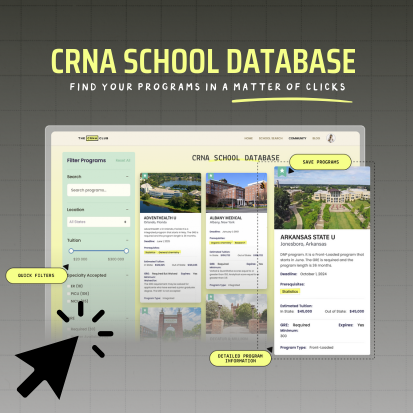If you’re knee-deep in CRNA school didactics, this post is for YOU! As I near the end of my first year, I can confidently say: there is light at the end of the tunnel. If your program is anything like mine, you’re constantly finding yourself trying to balance time, stress, and the impossible task of keeping a personal life. Let me save you a little trial and error — here are the study methods that worked for me and my classmates!
1. Spaced Repetition: My Secret Weapon
Before school started, I read the book Make It Stick — highly recommend. It convinced me to ditch cramming for good!
Spaced repetition works by reviewing material over increasing intervals, reinforcing long-term memory. I used apps like Quizlet, Brainscape, and ultimately landed on Anki — my go-to.
In semesters packed with 17+ credit hours (mostly heavy on the science), I set a daily minimum: 50 flashcards per subject. Every. Single. Day. By exam week, I wasn’t scrambling — I knew what I knew and could zero in on the tough stuff.
2. Group Study: A Game-Changer
If you’re trying to get through CRNA school without a solid study group… PLEASE rethink that.
Even if you’re more of a solo studier (me 🙋🏻♂️), having 3–5 reliable classmates to talk through concepts with is invaluable. They’ll fill gaps you didn’t know you had and help you see things from new angles. SERIOUSLY, do not sleep on this method. “Two heads are better than one”.
Bonus: there’s too much content to cover solo. Divvying up notes and sharing summaries can seriously save you time and sanity.
3. Concept Mapping: Think Big Picture
This one was a lifesaver for A&P. With all the anatomy structures, physiology concepts, and disease processes coming at you, it’s easy to get overwhelmed.
I’d read through my notes, sketch out concept maps, and condense key ideas into 1–2 word summaries. It helped me see how everything connects — essential for application-based exams (which most of them are in CRNA school!).
CRNA school isn’t just about memorization; it’s about understanding systems and patterns. Concept mapping trains you to zoom out and think like a clinician.
4. Pomodoro Method: Focus in Bursts
This is hands-down my favorite technique.
The Pomodoro Method breaks study time into focused 25-minute blocks with 5-minute breaks in between. After 4 cycles, you take a longer 15-minute break (this is totally customizable, by the way).
It’s perfect if you’re easily distracted (again, me 🙋🏻♂️). I use the Flow app on my desktop — it not only times your sessions but also blocks apps like Instagram or Messages to keep you on track. YouTube also has great Pomodoro playlists if that’s more your vibe.
Final Thoughts: Find What Works, Fast!
These are just a few methods my classmates and I swear by. The truth is, no one really teaches you how to study in school — you figure it out through trial, error, and lots of late nights.
Unfortunately, CRNA school doesn’t give you much time for trial. You’ve got to hit the ground running with a plan that works for you.
So take what’s useful here, experiment with what fits your style, and remember: your adaptability and efficiency are everything. You can do this. Keep going — and best of luck! 💪🏽
Ready to find your perfect CRNA school match? Use our CRNA School Database to quickly filter and find programs you meet the requirements for in a matter of clicks!



